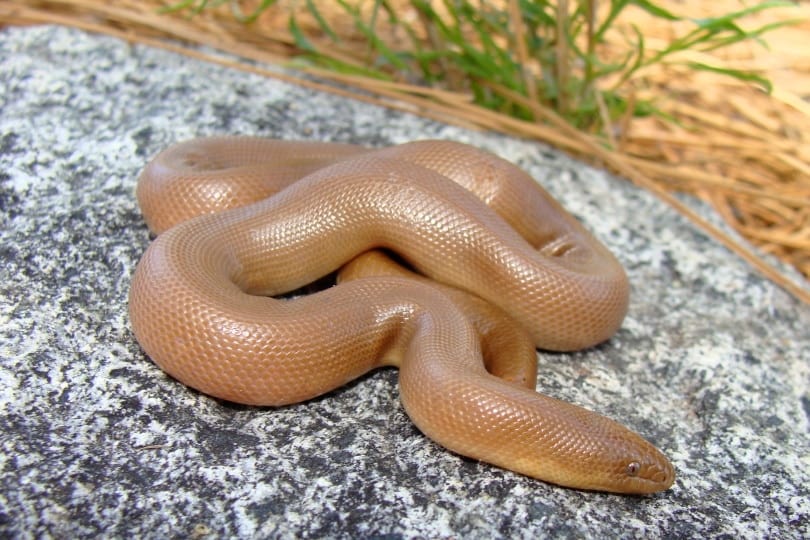Many snakes are cool and fun to look at, but some would bite you as soon as look at you. In many cases, it can be hard to tell the friendly snakes from the monsters.
Fortunately, in California, that’s not much of an issue. There are only a few species of venomous snakes in California, and they are fairly easy to spot.
There are snakes all over the state, although they’re more predominant in the desert regions. Here, we look at the ones that you’re most likely to find while wandering around in California.

The 9 Snakes Found in California
1. Coachwhip (or Racer) Snake
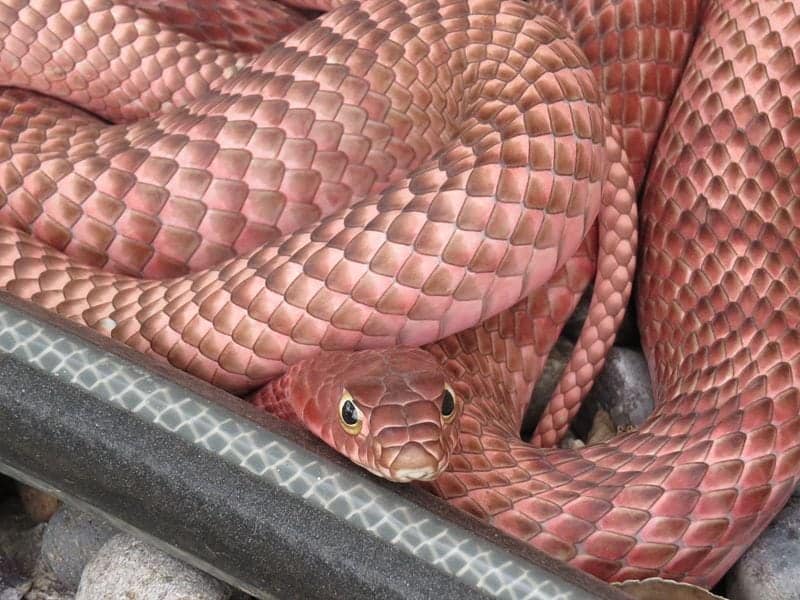
| Species: | M. flagellum |
| Longevity: | 16 years |
| Good to own as a pet?: | Yes |
| Legal to own?: | Yes |
| Adult size: | 6–8 feet |
| Diet: | Carnivorous |
They like open habitats and sandy soil, and they’re often found in forests, deserts, and farmlands. They’ll eat just about anything that they can fit in their mouths, including lizards, mice, insects, birds, and other snakes. They aren’t venomous nor are they constrictors; they just grab their prey and swallow them whole.
Coyotes, foxes, and birds of prey will all eat coachwhips. There’s no telling how these snakes will react when threatened. Some get quite aggressive, while others prefer to play dead. Despite their names, they won’t actually whip you (nor are they likely to coach you), and they typically prefer to run away rather than confront danger head-on.
2. Western Rattlesnake
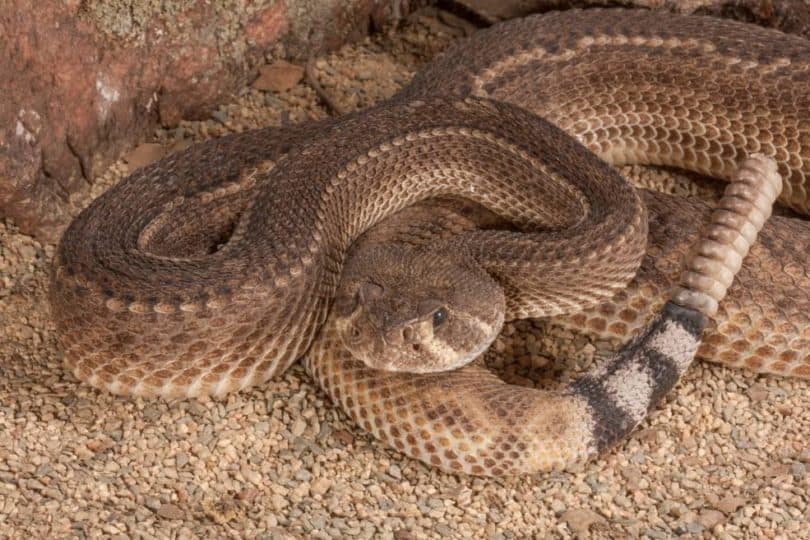
| Species: | C. oreganus |
| Longevity: | 20 years |
| Good to own as a pet?: | No |
| Legal to own?: | No |
| Adult size: | 4–6 feet |
| Diet: | Carnivorous |
They can be found in urban environments too, with most human interactions coming on hiking trails and places of that nature. Dogs and other pets are more likely to get bit than humans, though. Unfortunately, while the telltale rattle is the easiest way to identify these snakes, it’s not foolproof, as their rattles can break off.
These snakes eat birds, rodents, insects, and eggs, while birds, coyotes, bobcats, and other snakes like to eat them. Many animals will kill them on sight, even if they don’t eat them; these include deer, antelope, cows, horses, and of course, humans.
3. Pacific Gopher Snake

| Species: | P. catenifer |
| Longevity: | 15 years |
| Good to own as a pet?: | Yes |
| Legal to own?: | Yes |
| Adult size: | 3-7 feet |
| Diet: | Carnivorous |
They’re usually dark brown, green, or yellow, with spots and mottles all down their backs. When threatened, they may hiss or shake their tail like a rattlesnake; this is all a bluff, though, as they’re non-venomous. Unfortunately, since rattlesnakes sometimes lose their rattles, it’s easy to mistake gopher snakes for their more menacing cousins.
Gopher snakes mostly eat small rodents, such as gophers, but they’ve also been known to eat birds, eggs, lizards, and even bats. They’re often preyed upon by foxes, red-tailed hawks, and coyotes, none of which are impressed by their rattlesnake impression.
4. California Kingsnake
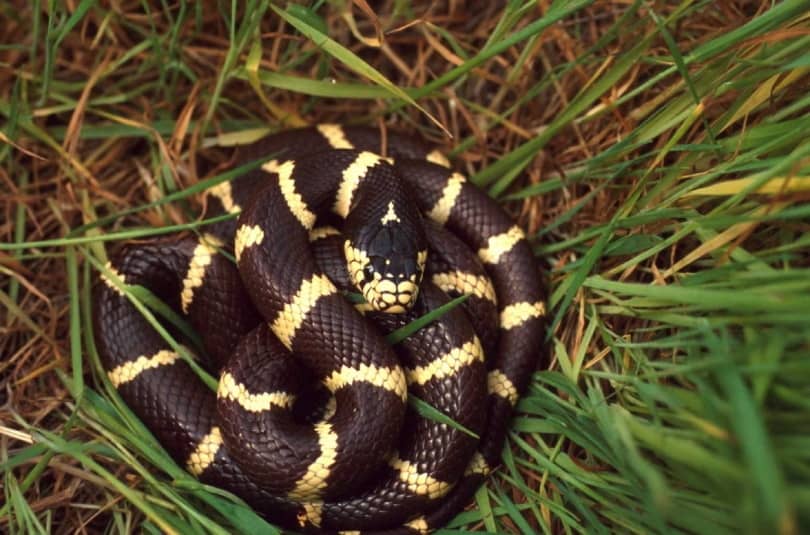
| Species: | L. californiae |
| Longevity: | 20 years |
| Good to own as a pet?: | Yes |
| Legal to own?: | Yes |
| Adult size: | 3-5 feet |
| Diet: | Carnivorous |
Like gopher snakes, they’re harmless to humans, but they’ll also mimic a rattlesnake’s tail rattle if threatened. When confronted by humans, they’ve been known to bite, hiss, and excrete musk or fecal contents from their cloaca.
They’re called kingsnakes for a good reason: Other snakes give them a ton of respect. In fact, snakes make up a large portion of their diet, and they’re largely immune to rattlesnake venom, so those reptiles have no way to defend themselves from an approaching kingsnake. Kingsnakes are constrictors, so they’ll wrap a rattlesnake up and suffocate them before sucking them down like spaghetti.
Of course, not everyone respects royalty, and these snakes are often killed and eaten by hawks, owls, coyotes, possums, and skunks.
5. Western Yellow-Bellied Racer
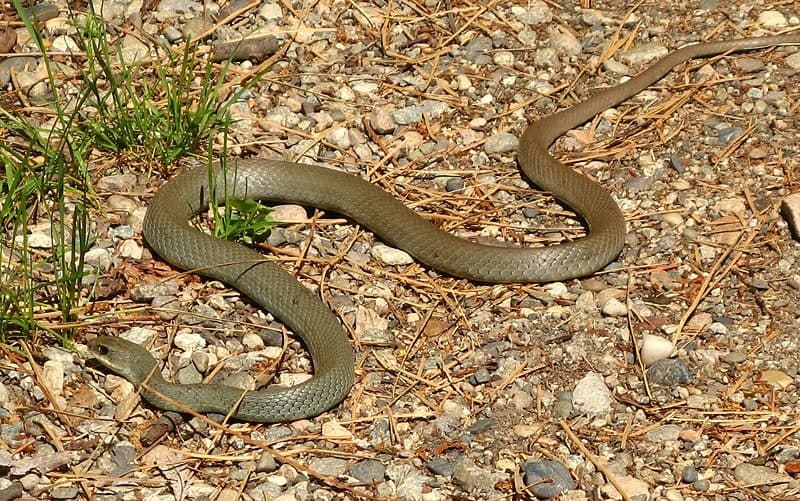
| Species: | C. constrictor mormon |
| Longevity: | 10 years |
| Good to own as a pet?: | Yes |
| Legal to own?: | Yes |
| Adult size: | 3-6 feet |
| Diet: | Carnivorous |
As juveniles, they mainly eat insects, but as they grow, they’ll branch out into eating birds, eggs, squirrels, turtles, rabbits, and even larger snakes. While they may have the word “constrictor” in their scientific name, these snakes don’t suffocate their prey, preferring instead to swallow it whole.
These snakes are hunted by all the usual suspects (birds, coyotes, and other snakes), but the biggest threat to them usually comes from humans. They don’t do well in urban environments, so suburban sprawl can threaten their existence, and let’s just say that they’re not exactly pros at crossing the road.
6. Ring-Necked Snake
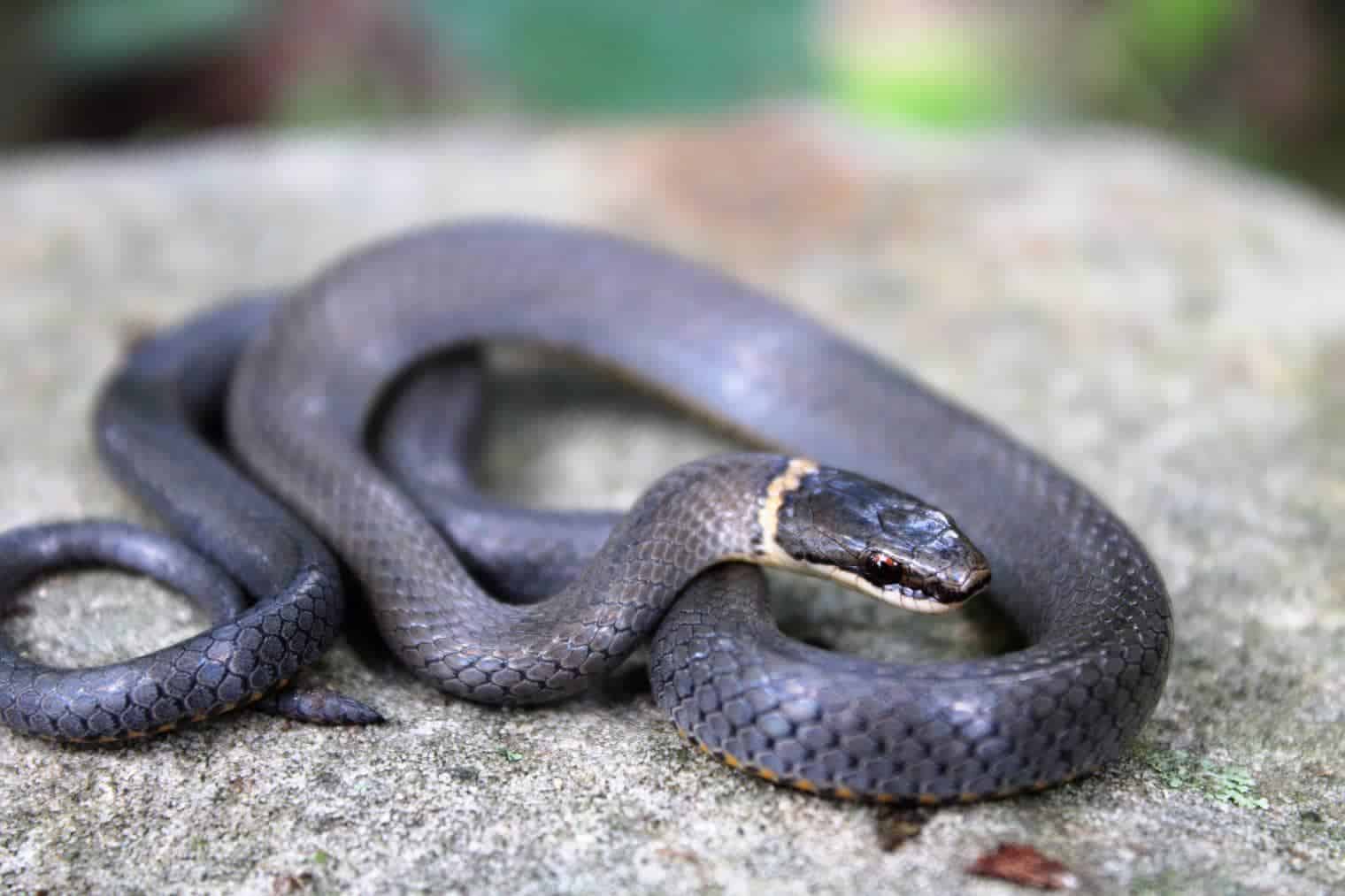
| Species: | C. sculpturatus |
| Longevity: | 10 years |
| Good to own as a pet?: | Yes |
| Legal to own?: | Yes |
| Adult size: | 10–20 inches |
| Diet: | Carnivorous |
As you might expect, given how little these creatures are, they like to live in places where they aren’t exposed. They’ll stick to woodlands or marshes for the most part, and they love to burrow down into moist soil, where they’ll hunt salamanders, slugs, and worms. They can be snacks for hogs, frogs, owls, skunks, armadillos, and more.
These snakes are venomous, but their method of injecting the venom differs from rattlers and other vipers in that the ring-necked snakes have venom glands in their back teeth. They’ll bite their prey, chew on it a bit to inject some venom, and then constrict them to finish them off. Their venom is far too weak to pose a danger to humans, however, and they’re considered completely harmless (although their chomps can still hurt).
7. Garter Snake
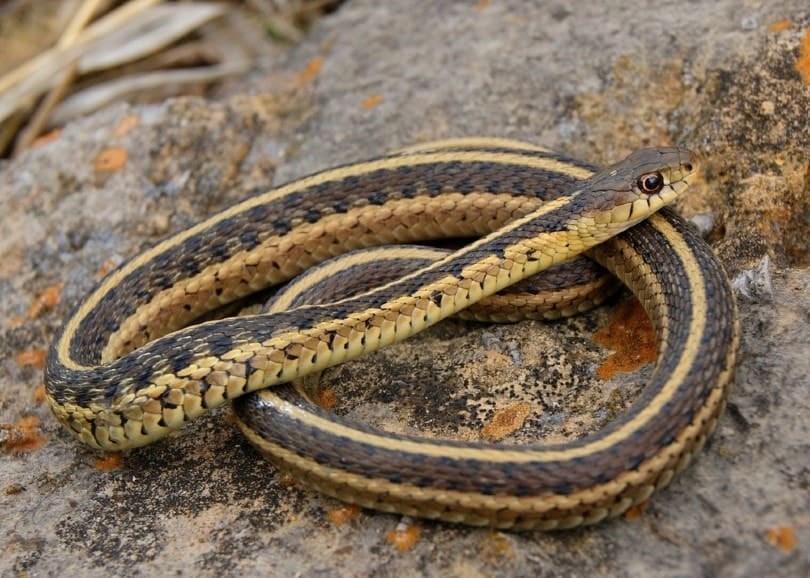
| Species: | T. sirtalis |
| Longevity: | 5 years |
| Good to own as a pet?: | Yes |
| Legal to own?: | Yes |
| Adult size: | 18–54 inches |
| Diet: | Carnivorous |
They can be found all over America, in a variety of habitats, and they’re one of the most common water snakes in California. They can also be found in forests, fields, and often, people’s lawns. Regardless of where they live, though, you can bet a water source is nearby, as they don’t stray too far from rivers, lakes, and streams.
Frogs and other amphibians make up the bulk of their diet, and they can fall prey to birds, large frogs, snapping turtles, squirrels, foxes, and more.
8. Sharp-Tailed Snake

| Species: | C. tenuis |
| Longevity: | 10 years |
| Good to own as a pet?: | Yes |
| Legal to own?: | Yes |
| Adult size: | 12–20 inches |
| Diet: | Carnivorous |
These small snakes are usually brown or light red, and they do actually have a sharp tail, which is due to their final vertebrae protruding out the tip. They use this to hold up prey while they swallow it, which comes in handy due to the fact that they primarily eat slippery, slimy slugs. Neither their tail nor their teeth pose any threat to humans.
Many people mistake these little guys for worms, and they tend to roll up in a ball when threatened. That doesn’t stop other snakes, raccoons, and shrews from dining on them, however.
9. Rubber Boa

| Species: | C. bottae |
| Longevity: | 7 years |
| Good to own as a pet?: | Yes |
| Legal to own?: | Yes |
| Adult size: | 1–3 feet |
| Diet: | Carnivorous |
Rubber boas get their name from the fact that they have dark scales that hang loosely on their bodies; they’re also quite smooth and shiny, giving them a rubber-like appearance. Their tails are flat and blunt and resemble their heads at first glance; this can protect them from predators, like birds that would try to attack their faces.
This is one of only two boa species that are native to the United States; the other species, the rosy boa, is also found in California (though not as frequently as the rubber boa). They can tolerate colder temperatures than most other snakes, so they can often be found at elevations of 10,000 feet or more. They spend most of their time under rocks, logs, or other shelter.
They aren’t venomous and aren’t the least bit aggressive. They usually won’t bite humans even if threatened (although they will shoot a potent musk at you). They primarily eat small mammals like mice and voles, and if they encounter nesting animals, they’ll eat the litter first while using their tail to keep the mother at bay. However, this doesn’t work well against coyotes, birds, cats, and other animals that like to snack on these boas.

Conclusion
There are dozens of snake species in California, the overwhelming majority of which are quite harmless. In fact, these reptiles make a massive contribution to the ecosystem, helping to keep the populations of problematic species like rodents under control. This can prevent both crop failure and the spread of diseases.
See Also:
- 10 Small Pet Snakes: That Stay Small (With Pictures)
- 19 Snakes Found in Ohio (With Pictures)
- 25 Snakes Found in Colorado (With Pictures)
Featured Image Credit by Matt Jeppson, Shutterstock
